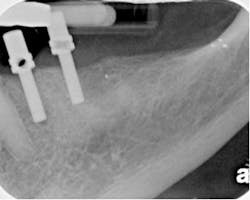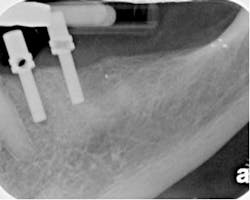Twisted files
By Richard E. Mounce, DDSRecently I received this letter from a colleague who asks several important questions worthy of discussion. The question has only been correctly for spelling and grammar. “Dear Richard,
I enjoy reading your essays and articles ... I have used Tulsa rotary files for many years and feel comfortable with them but have often been unhappy with the lack of consistency of the size match of their files to their master cones. I have been thinking of changing and reviewed your article … describing the advantages of Sybron’s Twisted File. It sounds great and worth changing over to. My number one priority is to do right by my patients, which is why I am writing you. It is not clear in the journal article, so I need to ask you ... do you have any affiliation with SybronEndo? Please forgive me for asking, but this is the way dentistry is going these days. Are they paying you for your endorsement in any way, whether it is in consultant/research money or benefits to you or your family? As I said, I enjoy reading your editorials and articles and look forward to any future ones!”
I enjoy reading your essays and articles ... I have used Tulsa rotary files for many years and feel comfortable with them but have often been unhappy with the lack of consistency of the size match of their files to their master cones. I have been thinking of changing and reviewed your article … describing the advantages of Sybron’s Twisted File. It sounds great and worth changing over to. My number one priority is to do right by my patients, which is why I am writing you. It is not clear in the journal article, so I need to ask you ... do you have any affiliation with SybronEndo? Please forgive me for asking, but this is the way dentistry is going these days. Are they paying you for your endorsement in any way, whether it is in consultant/research money or benefits to you or your family? As I said, I enjoy reading your editorials and articles and look forward to any future ones!”
Clinical case (#28-29) treated with the Twisted File* and RealSeal* master cones trimmed for tugback as described in the article.One of the issues raised is clinical and the other is related to commercial interest. With regard to commercial interest, I am on the advisory board of SybronEndo and receive an honorarium for some aspects of that work, for example lectures. I am not incentivized to sell Twisted Files (TF) or receive a royalty for TF sales. I use TF because in my hands it is the finest rotary nickel titanium (RNT) file on the market today and for no other reason. Clinically, the clinician raises an important point regarding the match between master cones and RNT file sizes. It can be challenging to get a consistent fit between the taper and tip size of a given RNT and a matching master cone. The source of this discrepancy is not difficult to understand. The tolerances for RNT manufacture allow a #25 tip size instrument to actually be slightly larger or smaller (a #24 or a #26, for example). The tolerances for master cones are similar (a #25 master cone can also be a #24 or #26). If the RNT master apical file is a #24 at the tip and the master cone is a #26, it is unlikely that it will fit easily to length. Larger ISO deviations can only provide even greater discrepancies between the RNT file and the master cone. As a result of this, many specialists choose a “universal” master cone and trim the cone to the true working length to achieve tugback. Trimming master cones is simple, efficient, and preferable to carrying an inventory of multiple cones of various tip sizes and tapers. In essence, most specialists do not rely on master cones of the same taper and tip size to match the last RNT file size used. For example, I use TF* for canal preparation. If I create a .08 taper along the length of the root (due to TF’s greater cutting ability and flexibility allowing preparation of such a taper along the length of the root) and I subsequently prepare a master apical diameter of a #50 tip size with a .04/50 TF, my choice of master cone to fit such a preparation requires trimming the master cone to achieve tugback at the true working length. This requires explanation. First off, the final prepared taper is less relevant to the master cone fit than the master apical diameter. The master cone should fit with tugback to the minor constriction (MC) of the apical foramen. Tugback in this context means that the cone should fit to the MC, with and without sealer, and resist coronal displacement. This resistance to coronal displacement occurs because the cone is intimately in contact with the walls of the canal in the apical 3-4 mm. The cone should only contact the walls of the canal at this level and not higher up. It has value to review the math of what the numbers mean when reviewing tip diameters. A #50 ISO tip size is .5 mm at the tip. Hand K files are generally .02 tapered. With several exceptions, RNT files have fixed tapers of .02, .04, .06, .08, .10, and .12. A .04-tapered instrument increases .04 mm per mm as the clinician moves up the file away from the tip. If the tip size is a #20 ISO (.20), 1 mm from the tip, a .04-tapered instrument is .24 mm, 2 mm from the tip; it is a #28 (i.e., .28 mm), etc. Tugback can be achieved by trimming subsequently 0.5-1 mm portions of the master cone until the cone has tugback at the true working length. Specifically, if for example, the master apical diameter is a #50 ISO size, a .06/20 master cone is a #50 ISO size 5 mm back from the tip of the instrument. 1 mm back from the tip of the master cone the diameter of the cone is a .26 mm. 2 mm back the diameter is a .32 mm. 3 mm back the diameter of the tip is .38 mm, 4 mm back the diameter is .44 mm and 5 mm back it is .50 mm. This tip diameter is identical to the tip diameter of a #50 ISO instrument.As a result, in the clinical example of a cone fitting a .08 tapered preparation, which has been apically enhanced to a #50 master apical diameter, the clinician can use a .04, .06, .08 master cone and trim the tip to achieve tugback at the apex. The reason that any one of these master cones can be used to achieve tugback is that each of these smaller tapers fit inside the greater master apical taper that has been prepared, in this example a .08 taper. Said differently, a .04 taper fits inside a .08 taper, a .06 taper fits inside a .08 taper, etc. A clinically relevant discussion of cone fit has been addressed. Emphasis has been on trimming master cones to gain efficiency and mastery over the achievement of tugback. I welcome your feedback. * SybronEndo, Orange, Calif., USA
Dr. Mounce lectures globally and is widely published. He is in private practice in endodontics in Vancouver, Wash.


